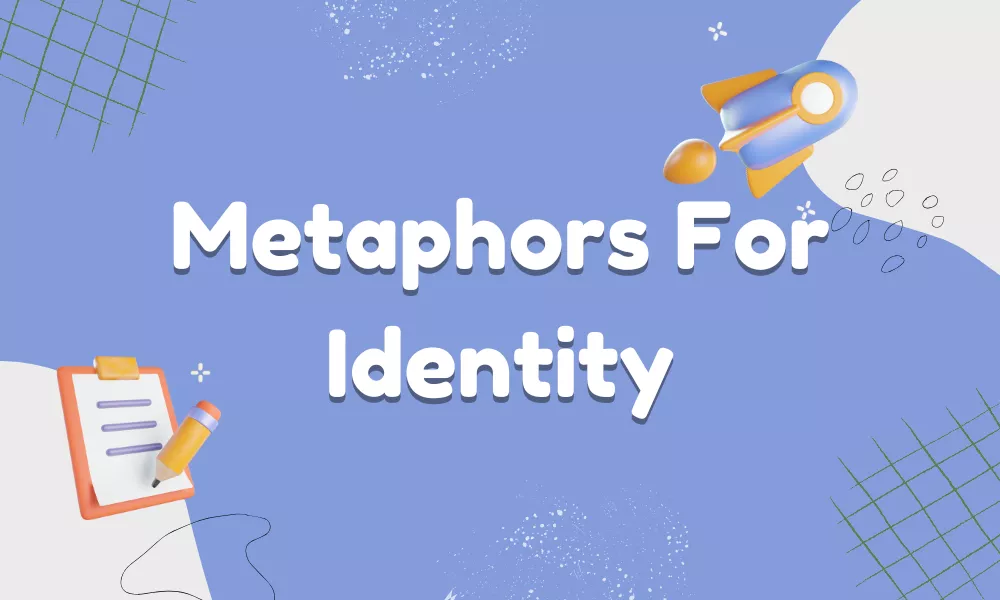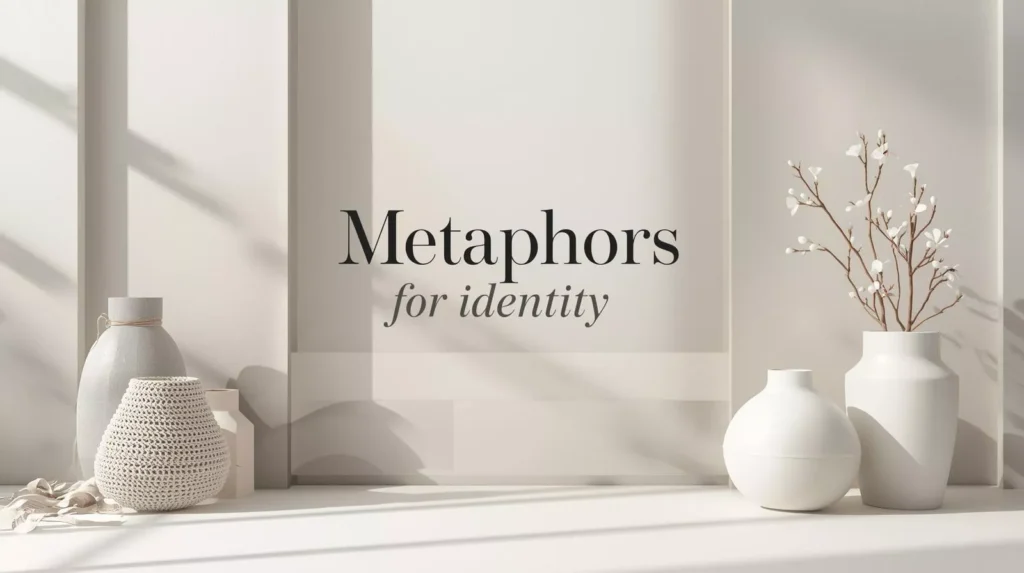Metaphors for Identity – Meaning, Examples and Deep Understanding

Our identity is like a living story which is constantly growing, shifting, and shaped by every choice, experience, and connection we make. To understand this complex idea, we often turn to metaphors, which give abstract concepts a vivid, human touch. Imagine identity as a puzzle, where each piece comes together to form a complete picture of who we are. Or as a tree, with deep roots symbolizing our origins and spreading branches reflecting our personal growth. Through such metaphors, we can explore and express the many layers of ourselves in meaningful ways.
What Are Metaphors for Identity?
Metaphors for identity are imaginative comparisons that help us understand who we are by relating our sense of self to familiar objects, ideas, or experiences. Instead of describing identity in abstract terms, metaphors give it shape and emotion, something we can visualize and feel. For example, someone might describe their identity as a journey to show personal growth over time, or as a mirror to express self-reflection and awareness. These metaphors reveal how identity is not fixed but constantly evolving, influenced by our relationships, culture, values, and life experiences.

Everyday Metaphors for Identity
- Identity is a Puzzle
Meaning: Our identity is made of different pieces that fit together to form who we are.
Example: Over the years, I’ve slowly put together the puzzle of who I am. - Identity is a Mirror
Meaning: It reflects how we see ourselves and how others perceive us.
Example: My identity acts like a mirror, showing both my strengths and flaws. - Identity is a Journey
Meaning: It changes and evolves as we grow and experience life.
Example: Finding my true identity has been a lifelong journey. - Identity is a Tree
Meaning: Our roots symbolize our origins, and branches represent growth and transformation.
Example: My cultural identity is like a tree rooted deeply in my ancestors’ traditions. - Identity is a Canvas
Meaning: We create and color our identity with our choices and experiences.
Example: Every decision I make adds a new stroke to the canvas of my life. - Identity is a Book
Meaning: Each chapter represents a stage or experience in our lives.
Example: My identity book has many chapters, each teaching me something new. - Identity is a Mask
Meaning: Sometimes, we hide our true selves or show only parts of who we are. Example: I used to wear a mask to fit in, but now I’m learning to be authentic. - Identity is a River
Meaning: It flows and changes constantly, shaped by external influences.
Example: My sense of identity has flowed like a river, adapting to new paths. - Identity is a Tapestry
Meaning: It’s woven from many threads; culture, family, and experience.
Example: My life is a tapestry stitched from love, struggle, and hope. - Identity is a Garden
Meaning: It grows when nurtured and changes with time and care.
Example: My personality bloomed like a garden once I learned self-acceptance. - Identity is a Map
Meaning: It helps us navigate who we are and where we’re going.
Example: I’m still drawing the map of who I want to become. - Identity is a House
Meaning: Built over time with memories, values, and experiences.
Example: My identity is a house filled with the voices of my past. - Identity is a Mirror Maze
Meaning: It can be confusing, with multiple reflections of who we are.
Example: At times, my identity feels like a maze of mirrors I’m trying to escape. - Identity is a Shadow
Meaning: It follows us everywhere, yet sometimes we can’t fully see it.
Example: My identity shadow grows as I become more aware of myself. - Identity is a Flame
Meaning: It burns within us, symbolizing passion and inner strength.
Example: My identity flame keeps me warm through life’s cold moments. - Identity is a Song
Meaning: Every person’s identity has its own rhythm and tone.
Example: My identity is a song composed of laughter, loss, and love. - Identity is a Shell
Meaning: It protects who we are inside while showing a part of us to the world.
Example: My outer shell hides the softer parts of my identity. - Identity is a Path
Meaning: It’s the direction we take in life, defined by choices.
Example: I’m walking a path that helps me discover my true self. - Identity is a Key
Meaning: It unlocks our purpose and connection to others.
Example: Self-awareness is the key to understanding my identity. - Identity is a Quilt
Meaning: It’s made up of different patches of experience sewn together.
Example: My quilt of identity includes pieces of family, travel, and love. - Identity is a Storm
Meaning: It can be turbulent, yet it clears the way for growth.
Example: My teenage years were a storm that shaped who I am today. - Identity is a Bridge
Meaning: It connects our past with our present and future.
Example: My bilingual identity serves as a bridge between two cultures. - Identity is a Mirror Reflection
Meaning: It’s how we see ourselves versus how others see us.
Example: My reflection changes depending on who’s looking. - Identity is a Seed
Meaning: It starts small and grows with time and experience.
Example: My sense of self began as a seed planted by my parents. - Identity is a Road
Meaning: It leads us through different phases of life.
Example: I’ve taken many roads to find my authentic self. - Identity is a Cloak
Meaning: Something we wear or reveal differently in various situations.
Example: I change my identity cloak depending on who I’m with. - Identity is a Lens
Meaning: It shapes how we view the world and ourselves.
Example: My cultural identity acts as a lens through which I see everything. - Identity is a Compass
Meaning: It helps guide our decisions and direction in life.
Example: My values serve as the compass for my identity. - Identity is a Web
Meaning: It connects all aspects of who we are into one whole.
Example: My identity web ties together my beliefs, dreams, and roots. - Identity is a Flame in the Wind
Meaning: It’s fragile but persistent despite challenges.
Example: My inner identity flame flickers, but it never goes out. - Identity is a Portrait
Meaning: It’s the picture of who we are painted over time.
Example: My life is a portrait still being painted. - Identity is a Shell on the Shore
Meaning: It’s shaped by the waves of life and time.
Example: My identity shell has been smoothed by countless experiences. - Identity is a Mirror of the Soul
Meaning: It reflects our deepest values and emotions.
Example: My actions mirror the soul of my true identity. - Identity is a Firework
Meaning: It bursts with color and individuality.
Example: Her identity shone like a firework at every event. - Identity is a Clothing Wardrobe
Meaning: We choose and change aspects of ourselves like outfits.
Example: I switch identities like outfits depending on the situation. - Identity is a Mountain
Meaning: It’s built through struggle, strength, and endurance.
Example: My identity mountain was carved by hardship and hope. - Identity is a Diamond
Meaning: It forms under pressure and shines with uniqueness.
Example: My identity diamond sparkles with resilience. - Identity is a Mirror Pool
Meaning: It reflects depth and clarity when we look within.
Example: Meditation helps me see my identity clearly in the mirror pool. - Identity is a Home
Meaning: It’s the safe space where we feel most like ourselves.
Example: My identity feels like coming home after a long journey. - Identity is a Flame of Light
Meaning: It guides us and reveals our inner truth.
Example: My identity light shines brightest when I’m authentic.
Cultural & Literary Metaphors for Identity
- Identity is a Mask (from theatre traditions)
Meaning: People show different identities in different roles, like actors.
Example: He wore many masks, each revealing a fragment of his identity. - Identity is a Mosaic (common in art and culture)
Meaning: It’s made up of diverse cultural pieces forming one picture.
Example: My multicultural identity is a mosaic of languages and customs. - Identity is a Mirror Stage (from Lacan’s theory)
Meaning: Identity begins through self-recognition and perception.
Example: In my mirror stage, I learned how others’ eyes shape who I am. - Identity is an Odyssey (from Homer’s epic)
Meaning: It’s a long, transformative journey of self-discovery.
Example: My identity odyssey took me across countries and cultures. - Identity is a Phoenix
Meaning: It can be reborn and transformed through life’s trials.
Example: After failure, I rose again like a phoenix with a stronger identity. - Identity is a Quilt of Nations
Meaning: It represents blended heritage and multicultural roots.
Example: My identity is a quilt stitched from my ancestors’ traditions. - Identity is a Mirror of Society
Meaning: It reflects cultural values and social expectations.
Example: My identity mirrors the balance between tradition and progress. - Identity is a Stage (from Shakespeare’s “All the world’s a stage”)
Meaning: We play different roles throughout life that shape who we are.
Example: On life’s stage, my identity evolves with every act. - Identity is a Labyrinth (from Greek myth)
Meaning: It’s complex, full of twists and self-discovery.
Example: My identity feels like a labyrinth with no clear exit. - Identity is a River of Memory (from cultural symbolism)
Meaning: It flows through generations, carrying history and memory.
Example: My family’s traditions run like a river through my identity.
Read: Metaphors for Cars
Creative & Modern Metaphors for Identity
- Identity is a Wi-Fi Signal
Meaning: It connects us to others and grows stronger when understood.
Example: My identity signal sometimes fades, but I always reconnect. - Identity is a Playlist
Meaning: Each song represents moods, experiences, or stages of life.
Example: My identity playlist plays everything from joy to heartbreak. - Identity is a Password
Meaning: It protects our individuality but can evolve over time.
Example: My identity password changes as I grow more self-aware. - Identity is a Software Update
Meaning: It improves and evolves through learning and experience.
Example: I’m constantly updating my identity with new insights. - Identity is a Profile Picture
Meaning: It shows one side of us, not the whole story.
Example: My profile picture identity hides more than it reveals. - Identity is a Hashtag
Meaning: It connects us to ideas, groups, and movements.
Example: My identity hashtag aligns with creativity and freedom. - Identity is a Digital Footprint
Meaning: It’s shaped by what we leave behind online and in life.
Example: My digital identity tells the story of my growth. - Identity is an App
Meaning: It can be customized, updated, or even reinstalled.
Example: My identity app runs smoother after I cleared old data. - Identity is a Filter
Meaning: It influences how we present ourselves to the world.
Example: I try to live without filters and show my raw identity. - Identity is a Cloud Backup
Meaning: Our memories and experiences are stored and carried through life.
Example: My identity cloud holds every version of who I’ve been.

Synonyms of Identity
| Synonym | Meaning |
|---|---|
| Self | The individual essence of a person; one’s true nature and consciousness. |
| Personality | The combination of traits, behaviors, and emotions that define how a person interacts with the world. |
| Character | The moral and ethical qualities that shape who a person is. |
| Individuality | The distinct traits or qualities that make someone unique. |
| Persona | The image or role a person presents to others, often different from their inner self. |
| Ego | One’s sense of self-importance or self-perception in relation to the outside world. |
| Nature | The inherent qualities or essence of a person or thing. |
| Being | The state of existence that encompasses one’s inner life and identity. |
| Essence | The core or fundamental qualities that define something’s true nature. |
| Selfhood | The condition of being an individual person, distinct and self-aware. |
How to Use Identity Metaphors in Writing & Speaking
- Use Metaphors to Show Growth and Change
In storytelling or personal essays, describe identity as something that evolves like a river that shifts course or a tree that keeps growing.
Example: “My identity flowed like a river, carving new paths with every experience.” - Connect Emotionally Through Visual Imagery
Use vivid, relatable images such as puzzles, mirrors, or gardens to help readers or listeners see your sense of self.
Example: “Each mistake I’ve made has become a new piece in the puzzle of who I am.” - Blend Cultural and Personal Layers
In reflective writing or speeches, combine cultural metaphors with personal growth to express complexity.
Example: “My identity is a mosaic of my heritage, my choices, and my dreams.” - Use Modern Metaphors for Relatability
When speaking to younger or contemporary audiences, use modern symbols like apps, playlists, or digital footprints.
Example: “My identity playlist changes every year, but the melody of self-respect stays the same.” - Contrast Metaphors to Show Conflict or Transformation
In creative writing, use opposing metaphors to highlight identity struggles or shifts like from a mask to a mirror.
Example: “For years, I wore a mask to please others, but now I stand before the mirror, unafraid of what I see.”
Read: Metaphors for Roses
Read: Metaphors for Buildings
FAQs
Conclusion
Identity is more than just a label, it’s the ever-changing story of who we are, shaped by our past, choices, and dreams. Through metaphors, we give life and emotion to this abstract idea, turning it into something we can visualize and feel. Whether you see your identity as a journey, a puzzle, a tree, or a digital profile, each metaphor helps uncover a new dimension of self-understanding.
